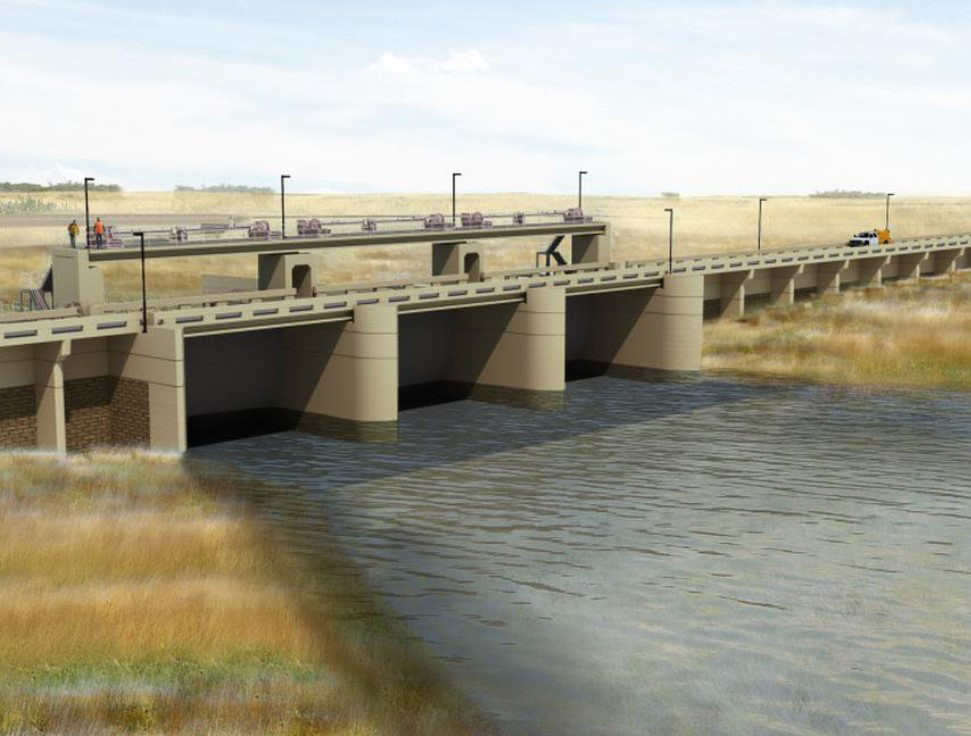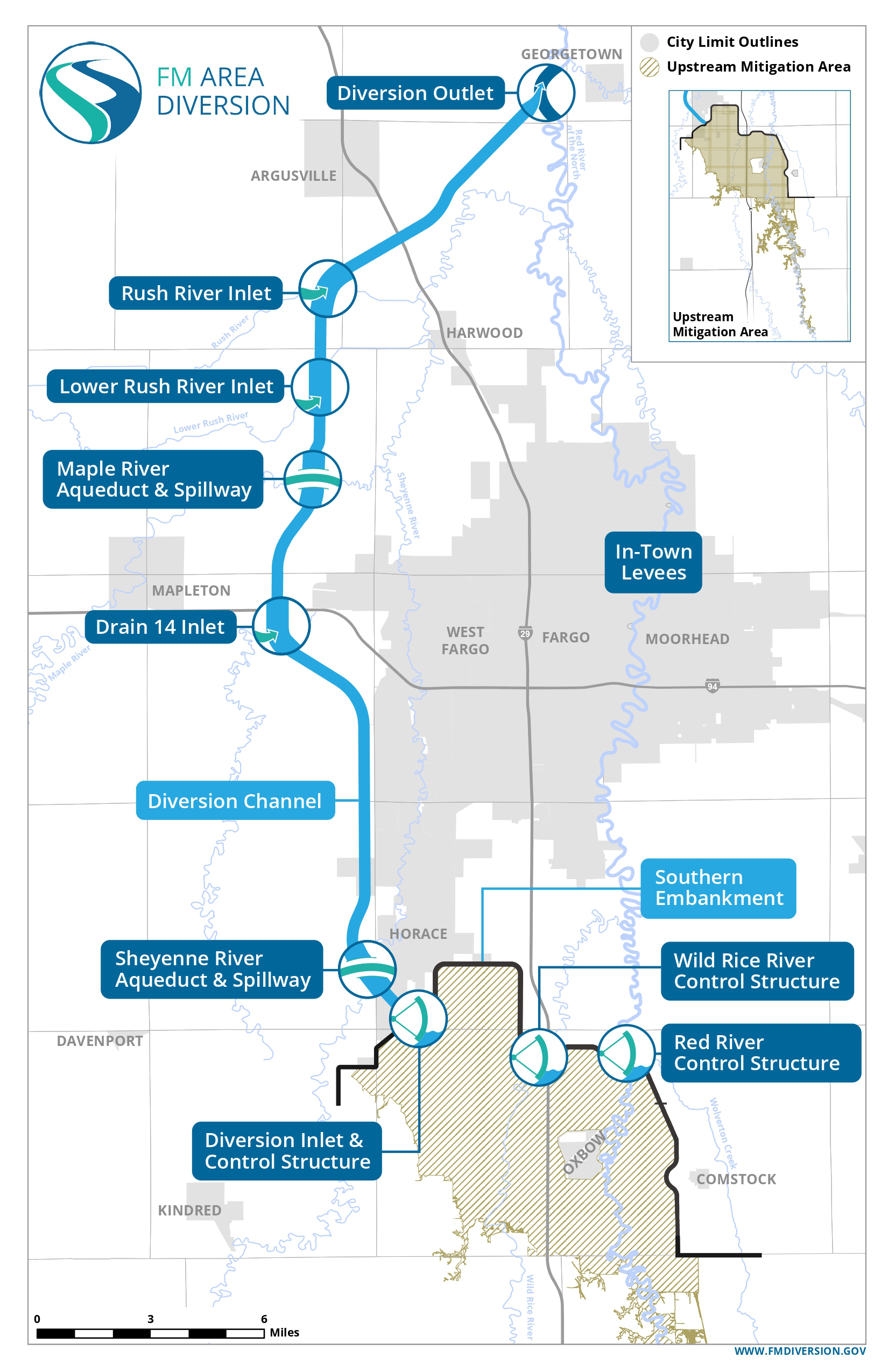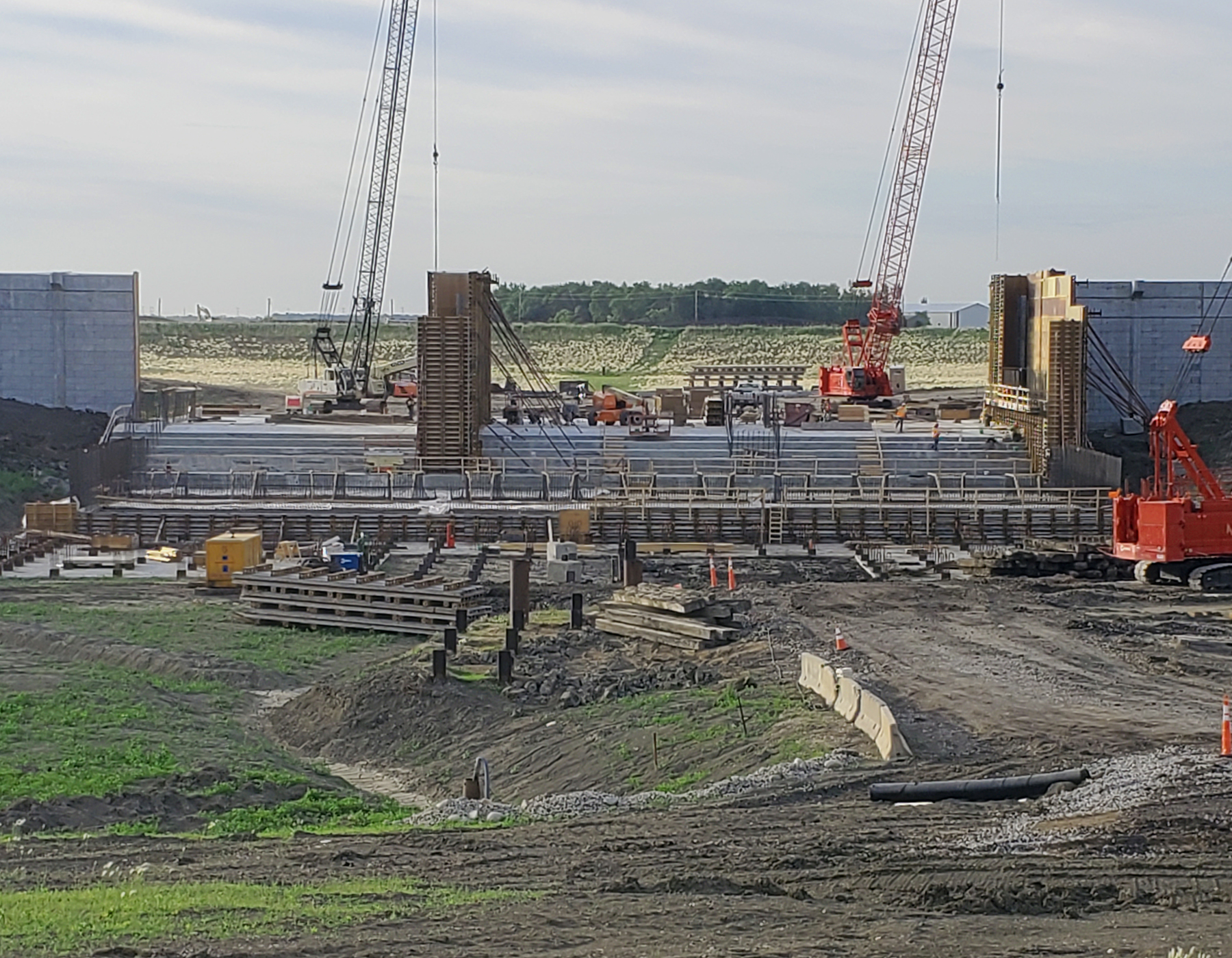By Jay Landers
The ongoing effort to reduce the risk of flooding in Fargo, North Dakota, and Moorhead, Minnesota, recently achieved a critical milestone when a private entity was chosen to deliver a key piece of a nearly $2.8 billion project via a public-private partnership. This is the first use of a P3 on a civil works project involving the U.S. Army Corps of Engineers.
The P3 agreement is expected to result in significant cost and time savings for the long-awaited project. The Fargo-Moorhead region now expects to receive permanent flood-risk protection more than a decade sooner and for hundreds of millions of dollars less than would have been possible with traditional project delivery methods.
In June, the Metro Flood Diversion Authority — a local governing authority formed in 2016 to oversee flood-protection efforts in the Fargo-Moorhead region — selected the Red River Valley Alliance to design, build, finance, operate, and maintain a 30 mi long diversion channel that will convey floodwaters around the two cities. The MFDA developed the project in conjunction with the U.S. Army Corps of Engineers.

Along with the channel itself, the $1.5 billion diversion project includes 19 highway bridges, four railroad bridges, two aqueducts, and other related features.
The risks of the Red River
As it flows north through the cities of Fargo and Moorhead on its way to Canada, the Red River has long posed a perennial threat of springtime flooding. However, this threat has worsened over time, says Joel Paulsen, P.E., M.ASCE, the executive director of the MFDA. “We’ve had a number of very wet decades over the course of the last 20-30 years,” Paulsen says. Analyses of the frequency of flood events and their peak crests have revealed a “very linear relationship,” he notes. “We kept seeing larger and larger crests and much more frequent (flooding).”
In spring 2009, the Red River crested at an all-time high of 40.83 ft, more than twice the flood stage of 18 ft, at the flood gauge in Fargo.
Sandbagging and other temporary flood-fighting efforts managed to stave off the worst of the flooding, but just barely. “We were within inches of losing the entire community,” Paulsen says. The close call prompted local governments to band together through a limited joint powers agreement signed in 2011 to begin developing what ultimately would become the diversion channel project.
Meanwhile, in 2016, the U.S. Federal Emergency Management Agency completed the process of updating its floodplain hazard maps for the Fargo-Moorhead area. The revised maps depicted essentially the “entire metro area” as being within the 100-year floodplain, Paulsen says. “Around 18,000 structures were mapped as having flood risk during the 100-year flood event,” he says.
Diverting the floodwaters
The sprawling Fargo-Moorhead Area Diversion Project is designed to route floodwaters around the metro area by means of three large control structures, a 20 mi long dam known as the Southern Embankment, and the 30 mi long diversion channel (see project map).
During periods of heavy flooding, large control structures located on the Red River and Wild Rice River will employ radial-arm floodgates to control the levels of water entering the metro area. Water that is blocked by the floodgates will collect behind the Southern Embankment and flow west toward the diversion channel. There, an inlet and control structure will direct flows of up to 20,000 cfs into the diversion channel, which will convey the water around the cities.

A diversion outlet at the northern end of the channel will return the water to the Red River. At the same time, water levels in the natural channel of the Red River will be limited to depths of 37 ft in the Fargo-Moorhead area. Although well above flood stage, the floodwaters will be safely controlled in the cities by levees, flood walls, lift stations, and related appurtenances.
The massive effort is designed to protect the region and its 230,000 residents from practically any foreseeable future flooding, Paulsen says. Besides providing certified 100-year flood protection, the project will “have the ability to fight much, much larger flood events with temporary measures,” he notes. “It’s going to be quite a robust project that will ensure the long-term integrity of the community and accommodate some impacts of climate change and different weather patterns in the future.”
Splitting project delivery
Funding for the overall project will come from multiple sources, according to the MFDA website. The federal government has committed $750 million, while local governments represented by the MFDA ultimately will pay $1.1 billion. The state of North Dakota has contributed $870 million, while the state of Minnesota is expected to contribute $86 million.
Given the scope and cost of the overall flood-risk reduction effort, the MFDA and the Corps devised a so-called split-delivery construction plan, under which the Corps assumed responsibility for designing and constructing the control structures and the Southern Embankment. The MFDA took responsibility for the diversion channel and its many related features.
The Fargo-Moorhead Area Diversion Project represents the first use of this split-delivery construction process on a Corps project, and it affords significant benefits for the federal government and the MFDA. “The Corps can do more work on larger flood-control projects with less federal resources and be able to get projects done much quicker,” Paulsen explains.
By implementing its portion of the project by means of a P3, the MFDA does not have to worry about cost overruns or scheduling delays. “We’ve got the certainty that it will be done in a timely fashion, and we get the certainty in the final cost,” Paulsen notes. “There’s a large risk transfer from the public side over to the private side, through the public-private partnership mechanism. The MFDA also gets the benefit of a 30-year design warranty because the P3 developer maintains the project features for 30 years after completion of construction as part of its bid.”
Another novel aspect of the split-delivery construction process is in its funding split.
Traditionally, the federal government funds 65% of the cost of civil works projects undertaken by the Corps, while local sponsors provide the remaining 35%. That was more than reversed in this project, according to Paulsen. Local sponsors and state funding are covering approximately 70% of the overall project cost.
The extra cost to the MFDA is worth it, Paulsen says, because it means the project will be completed much sooner than it otherwise would be under traditional Corps contracting methods. “Every year we go without having permanent flood protection, our communities are at risk,” he notes. “We want to get this done as quickly as possible.”
As for the project elements being overseen by the Corps, construction is underway on the diversion inlet and the control structure on the Wild Rice River. Ames Construction is the contractor for both projects. The Corps expects to complete the design of the Red River control structure by the end of August and to award the construction contract in 2022, says Terry Williams, the Corps’ program manager for the Fargo-Moorhead Area Diversion Project.

The Southern Embankment has been divided into seven reaches for the purposes of design and construction. One reach is under construction, and the rest are under various phases of design. Meanwhile, the Corps plans to award four construction contracts for the embankment in 2022, Williams says.
Thanks to the split-delivery construction process and the associated P3, the Fargo-Moorhead Area Diversion Project is expected to cost $330 million less and be completed 10 years sooner than if it were delivered by the Corps through its standard design-bid-build process, Williams says. In fact, the savings ultimately “could be higher,” Williams notes.
Proof of concept
In essence, the Fargo-Moorhead project has served as a proof of concept for efforts by the Corps to explore ways to expedite project delivery and use alternative financing mechanisms for civil works projects, Williams says.
“On big projects like this, it can take a very long time for federal appropriations to (reach) the level where you are able to build,” Williams notes. By dividing responsibility for the main project elements and implementing them simultaneously, the Corps and the MFDA increase the likelihood of “having an operational project in time for the next big flood,” she says. At the same time, the P3 process enables the nonfederal sponsors to “spread out that financing such that multiple generations are contributing to it and making it affordable,” she says.
The Fargo-Moorhead project is the furthest along of three projects currently included within a pilot program developed by the Corps to evaluate the feasibility of using P3s as part of civil works projects, says Aaron Snyder, the director of the Corps’ P3 program. The other two projects are the Los Angeles River Ecosystem Restoration Project and the Brazos Island Harbor Channel Improvement Project, which would entail multiple improvements to the Port of Brownsville in Brownsville, Texas.
Because the Corps lacks the authority to issue its own P3 contracts, it is looking for projects whose nonfederal sponsors are interested in possibly entering into such partnerships on their own, Snyder says.
“We actually leverage the nonfederal sponsor’s capability to issue those contracts,” Snyder says. To be considered for inclusion in the pilot program, a project must cost at least $50 million, though larger projects likely would make for better candidates, he notes. “We’re looking for the large projects that will take a lot of time typically under a traditional delivery method,” Snyder says.
Construction on the Fargo-Moorhead diversion project is expected to begin during the fourth quarter of 2021. The project’s flood-protection work is scheduled to begin in spring 2027, while final completion is scheduled for 2028, according to the MFDA’s release.
The Red River Valley Alliance, which was awarded the Fargo-Moorhead diversion project, is a consortium involving three equity members and a construction joint venture comprising three contractors, according to a June 18 news release from the MFDA. The equity members consist of Acciona S.A., Shikun & Binui Ltd., and North American Energy Partners Inc. The construction joint venture comprises Acciona Construction USA Corp., Shikun & Binui America Inc., and North American Construction Group.



